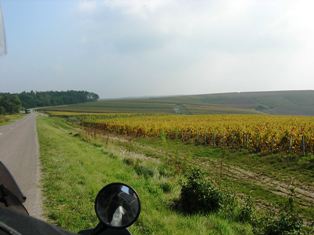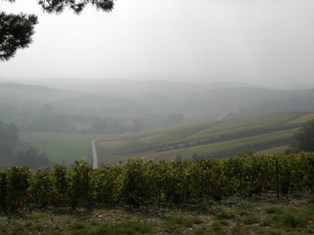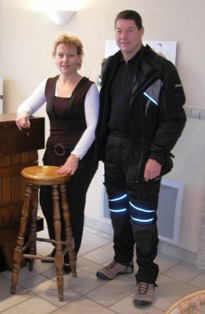A Tale of two wineries
Wine tasting in ChampagneA Tale of Two Wineries
Every year thousands of tourists flock to the village of Épernay, 25 km south of Reims in northern France, to visit the great champagne houses gathered along the av de Champagne. Even on the cool autumn day, well out of the tourist season, that we visit, there are enough visitors for the cellar tours to depart ever 20 minutes at the Moët et Chandon headquarters. Our group has about 15 English speakers including UK, US and Australian accents and we wait for our tour to start in a lavish hall displaying posters of beautiful young things, with perfect smiles, telling us that champagne is sophisticated.

Nowhere near as important as putting bubbles in beer!
We are guided by a young man, named Julian, with a soft French accent dressed in the corporate uniform of black suit, black shirt and black tie. He guides us through an in-house video that sets the tone with slick production but no useful information and a walk through parts of the 28 km of cellar tunnels set aside for tourists. He explains how champagne was made emphasizing hand turning bottles and long family traditions.
Skipped over in the presentation are the simple facts that champagne is made like any other modern wine; fermented in huge stainless steel vats in an industrial shed then turned and purged by machines. It has been made this way since the 1960s and it would be impossible to make a million bottles a year any other way.
Under questioning Julian admits that the family not longer controls the company which has been part of a conglomerate since the 1980s. The family values till drive the company we are assured.
We then appear in the tasting room for our one glass of the product before being abandoned in the boutique with the expectation that we will buy a bottle or two to take away with us.
We rush out into the cool autumn afternoon and leave without looking back sure that we have just been given a one hour advertisement for the champagne lifestyle and paid $20 for the privilege.
Épernay is the centre of a French marketing marvel that has sold wine with bubbles as a lifestyle accessory for 90 years. A visit to the great champagne houses, however, is not the whole story of the district or this amazing wine style.
While 75% of the vineyards legally able to provide grapes for true champagne lie in the Marne département around Reims and Épernay, the other 25% is situated more than 120 km south in the département of Aube. The wine growing area in Aube is more limited and centres on about 20 villages from Les Riceys in the south to Bar-sur-Aube 30 km to north east.
The Aube wineries have a long history of champagne production but, when the areas for inclusion in Champagnes Appellation dOrigine Contrôlée (AOC) were established in 1909, the Aube département vineyards were not included. 18 years of conflict, including crippling strikes and confrontation followed. The chaos was such that the Army was brought in to regain government control.

Riding through the Chardonnay vineyards in Aube is a delight.......

....even on a bitterly cold and foggy day!
By the time the dispute was settled and Aube was included in the areas of the Champagne AOC, the major producers of the north had established market dominance in a new, image driven, wine market. As a consequence, the southern wineries lack the pizzazz of the big names, but that doesnt diminish the quality of the product or experience of a visit.
We select a wine maker in the south at Celles-sur-Ource on the basis that they advertise that English is spoken and turn up at the door of Champagne Marcel Vézien unannounced. It is a bitterly cold foggy day and customers are thin on the ground. The locals complain that it is unseasonable weather but we suspect that they are just being polite to visitors.
This is a family business run by Jean-Pierre and Marie-José Vézien. There is no charge for tours or tasting and we settle into the warmth of the tasting bar with Marie-José for a chat about the history of the vineyard and the wines. There are no special tourist areas dedicated to the image of the product or the company. Jean-Pierre wanders through in work clothes for a chat. The business goes on around us.

Unfortunately the bike doesn't handle as well after excessive tasting of champagne, regardless of rider skill.
We select three champagnes for tasting, a chardonnay, a pinot noir and a rosé, and taste them in that order with the stronger rosé last. All have strong varietal character, interest and complexity. We purchase two bottles of the rosé to take with us for a friend in Belgium and a bottle of the chardonnay for that evening. Our host packs them in boxes for transport and throws in a reusable stopper, a pen, a key ring and smile.

These shelters, called cadole, were built in the fields by the workers to provide protection from the elements. These days,the workers jump in the mini-bus and whip into town for the two hour lunch break.
Caught somewhere between the marketing triumph of the Épernay houses and the small family vineyards of the Aube is a more complex and reassuring story than we had anticipated. To visit one is to find champagne as a lifestyle accessory prized for its brand name and exclusivity. To visit the other is to get involved with the wine for its own sake.
